I. Introduction
Culture takes place when the traveler is able to link found information to encountered space during a journey. From the block to the borough to the entire network of the city; diversified stories all call out at once, shouting for the attention of the dominant narrative. While each alternative narrative has its own richness and complexity, filtering through the overall information jam becomes essential.
What strategies can intrigue individuals’ consciousness of taping into the cultural knowledge already existing in public space, and how can each unique view be unveiled and represented?
The project Hide&SEEK approaches the future of cultural knowledge exchange by networking the public together through a found and catch cultural street game. Through providing a place for both “publication” and “transfer” of cultural knowledge, the proposed project will create a public user-generated cultural exploration for some of the most important topics of cities and communities. Our interest focused on getting people inspired to explore and share experiences that enrich everyone’s lives.
II. Preliminary Concept
Storytelling is an ancient form of entertainment where before books, and dvds were availible was tranfered from Storyteller to audience by simply word of mouth passed down from generation to generation. Then at some point the stories were lost to be later uncovered then adapted by the following civilization. Today society collectively tends to rely on the standard set of places to visit; museums, historical landmarks and other sites recognized as culturally important. Yet the city is composed of a myriad of different stories and memories, most hidden and untold, which have just as much value in the cultural heritage of the place (Miskelly, 2005). It is vital to be able to give a voice to allow such local narratives of place to be shared and continued. The Hide&SEEK project creates a framework for creating and sharing these personal experiences of place as a narrative game.
In 2007, Web 2.0 became a house hold word, but despite its popularity, is there surplus on both sides? It is positive to see a change in the thinking that web interfaces should focus on the needs of the users.
“Of course there is great opportunity with getting user involvement, but I think just another place where users can post pictures is not what the world needs. We really would like you to publish content we could interact with, but we don't just want another place where the sea of opinion never amounts to much. We want you to provide the structure for people to make something that gives back to the world.” (Cooney, 2007)
Does the cycle continue between on-line and physical spaces? Shall a museum’s web site become far more valuable than something typically only seen as a support for physical offerings (listing opening hours and ticket prices)?
“In order to extend and evolve their relationship with visitors, museums need to develop a holistic view of the audience’s journey across both the physical and virtual spheres. New media offers opportunities to engage the visitor within both the virtual and physical museum. It can continue visitors’ experiences beyond the walls of a museum and create a ‘virtuous circle’ between the virtual and physical space. The museum experience is therefore personalized and can be explored by visitors on their own time and to the degree that they wish.”(Barry, 2006)
The virtuous cycle of the reality. The world is covered by a digital layer allowing for us to tune and view the new possibilities of linking information to space. Knowledge comes from having information on hand, organized in such a way to be efficiently found, or through having it memorized. Prior to our contemporary information age, having the information on hand for a multitude of possible situations would become extremely heavy for one to carry. Today however, as information goes mobile and, in certain cases cities become completely WIFI, we are allowed to be more spontaneous while having the security blanket of knowing that a connection to the Internet exists at any location (even in mobile situations such as being on public transportation).
III. Hide&SEEK - The Game Experience
3.1. Three primary principles
When dealing with user participation, simplicity is key. The game experience is based on three basic principles; The incentive for the experience is based on providing a challenge, that challenge being related to the guest's awareness of the physical place, and that challenge being a personal invitation sent via a valued source.
3.1.1 The power of challenge: The culture through visual awareness
Hide&SEEK is a game played between ‘Hosts’ and ‘Guests’. Hosts invite Guests to follow their story through a sequence of challenge nodes. The game taps into the individual's conquest to overcome challenge. For both the Host and the Guest, the idea of the challenge shall hold their interest and heighten their awareness to continue publishing or playing the game-narrative to uncover and share culture.
There is actually no hiding being done in Hide&SEEK. The places that encompass different aspects of culture go through a continual sedimentation process that keep it hidden with every passing day. It shall be the pleasure of the Host to seek out the information behind the places they've uncovered (random/spontaneously), or to perhaps seek out places linked to the cultural knowledge they want to communicate.
A Hide&SEEK adventure can either guide a Guest along a path of the overwhelming amount of culture in certain cities while challenge you to dig deeper into the communities that on first impression seem to be like culture desserts. Everyplace provides an opportunity for the Host be a storyteller.
While getting back to the essence of the original children's game, without the challenge structure, the game would not be played. Children continue to play hide and seek; one child doing the hiding in places that they think are hidden from the other children seeking to find them. Where will they hide? What place are the others likely to totally overlook?
The same strategy holds true concerning the digital cultural narrative version. Preserving the spirit of the original game, prevents these cultural artefact's from going unread by the public to be forgotten. Now Hide&SEEK, intrigues not only children to ask;
Where is the hidden culture? What places have others already overlooked?
3.1.2 Visual clues in cultural hidden places
The ease of multi-media transfer throughout the advancement of the information age, has lead society to visually communicate with each other. The same strategy is used in the game to orientate people to find places where the information is hidden and where to look for clues to unveil the cultural significance behind the specific place shown in the multimedia. This is a challenge to find where this picture was taken? Do you know the history behind it? Is there a hidden story about its significance? Maybe there a clues from this picture that can relate to other parts of the adventure later on.
3.1.3 Sharing knowledge between Host and Guest
The adventure route (where Guests are guided to places they’ve never experienced before) is primarily executed on a walkable scale where one's awareness can properly focus on the individual challenge nodes, allowing them to play the game.
By accepting the invitation, the Guest places trust in the Host’s adventure. This confidence may help allow them to spot and act upon opportunities to further discover interesting people and situations along their route, over the years making a global cultural network.
In others cases, Guests may publish an open invitation asking possible Hosts to share an adventure with them. And reciprocally, a Host could have published their own interesting adventure with an open invitation for possible Guests who will be in the proximity to take on the adventure.
In any case, the game is played at a one to one level, where the players become something more than what could have started out as just being strangers. Hosts and Guests don't simply just exchange cultural knowledge. The game experience is happening on the street at a personal level allowing for a more intense connection to where the game is taking place.
The incentive of publishing cultural knowledge transfer is not a material reward, but rather the construction of a shared social experience; providing memories held in high regard of both game participants. Transmissions of high quality user generated content are ensured through both the relationship and responsibility that Hosts and Guests share with each other. This dynamic process of exchanging experiences directly often provide a far richer understanding of the constantly changing human and urban conditions than traditional organizations can't keep up with.
3.2 Four steps to SEEK
A well developed game has simple and easy to remember rules. Allowing for the players' creativity to expand upon the way in which culture is exchanged in this street game. Hide & Seek invites and challenges guests to partake on an sequenced adventure, which a Host has specifically created for them.
- Collect photos or other media of interesting discoveries from places.
- Formulate questions or thought provoking clues.
- Organize a sequence of these nodes for your guest.
- Invite Guest to partake on the adventure.
Want to say more? Simply tag guide notes, comments, pictures, videos, or any other known information. The interface shall provide the opportunity of displaying additional information in a specific location along the sequence that the Host has chosen to enrich their Guests adventure with.
Hide&SEEK is user-centric. The project was intended to be seen as less of a web interface, and more of a unique, fun, challenging, valuable, user created adventure platform. By allowing the Host and Guest to spontaneously publish or read a narrative, the mobile use of this game could change the way they explore, organize, and share their journey.
3.3 Perspective of a Host
The image of a tourist is likely to come to mind when describing the Host as a contemporary culture hunter, uncovering different place's hidden artifacts. However, Hosts explore places in a completely different way, without the overwhelming amount of advice and tips, from the tourist industry and guide books, and likely even without maps. Museums provide quality cultural context, but it's nearly impossible for them to alone have the responsibility of transferring all relevant information to the receiving public. Hosts are those self motivated scouts going farther off the beaten paths and then reporting back to the others what they feel is important up ahead. While taking into account the personal procession of the Guest, the Hosts adapts the interactive game dramaturgy through the narrative of culture that was uncovered at various physical places.
“So, we’re thinking about moving away from that and just usingcampus maps, or even Google Maps… or heck, lets scrap the maps all together. When someone tells you where they are, they can usually tell you where they are with enough accuracy to find them without the use of any kind of map whatsoever. So, maybe we can use that fact to our advantage. Combine this with maps, and it becomes very powerful.” (Mulka, 2006)
Photographic orientation has important advantages over traditional map orientation. Cartography is a skilled trade. Hosts making adventures tend to choose an orientation method that is direct, accurate, and that can respond quickly to their spontaneous exploration tactics. Taking a series of photographs Making an adventure for a Guest becomes as intuitive as walking experience for themselves. With photos visually displaying the quality of the game chapter's place, it’s possible for the Guest to gain a sense for the location perhaps before they even arrive. In regards to attaching the cultural clues and questions that will mentally challenge the Guests, the Hosts have a motivation to SEEK out this information. In order to write a question, one must have an answer in mind (requiring a general command of knowledge to the cultural aspect it's referring to).

Fig. 1: The Hosts tools for creating an adventure
3.4 Perspective of a Guest
The suspense of following each route looking for clues to answer the Host’s site-specific challenge, allows for a new heightened awareness of this space that Guests might have otherwise completely overlooked. By accepting the challenge, the Guest places trust in the Host’s adventure. This confidence may allow them to spot and act upon further opportunities of discovering interesting people and situations along the route, over time creating a global network of Culture exchange.

Fig. 2: The Guest on an adventure
IV. The Game Interface
The game is a narrative telling a unique story of cultural knowledge linked to multiple physical places. These elements are visualized into the interface as multiple chapters, where multiple chapters make up an adventure. The structure of the game allows for the Host to create as many chapters needed to the tell their story. The interface requires input of Host-generated multi-media elements (ex. digital photographs) that Hosts use to build up a personalized game. The interface's screen begins as a blank white pallet waiting for the Host who has the freedom to drag selected multi-media elements onto the display, becoming a chapter only after the Host attaches questions or clues that are derived from the cultural context that shall be communicated.
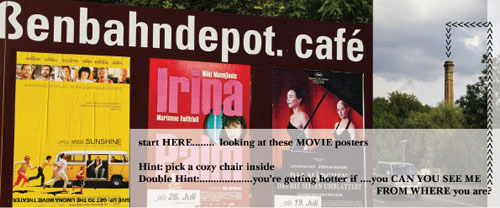
Fig. 3: An example of the start point of the game (extracted from a
paper prototype)
Once the game is complete and published to the Guest, they download the adventure route onto their mobile device. The adventure then starts when the Guest answers the Host’s starting point question by entering the answer into the mobile interface. If the answer matches the physical landmark where they are located then the first chapter of the adventure is activated. The adventure sequence is executed at a walkable scale; focusing on building the Guest’s suspense for the next chapter in the story. A chapter is successfully achieved when the riddle of the clue is entered into the game interface at the corresponding physical landmark. A game scenario is successfully accomplished when all clues at landmark nodes have been found and answered.
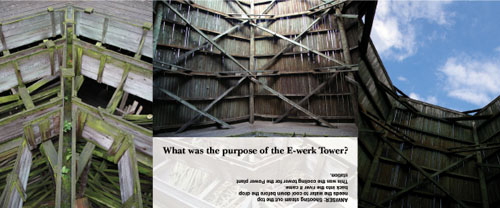
Fig. 4: An example of a game chapter (extracted
from a paper prototype)
Hide&SEEK adamantly disassociates its
mobile game interface from being regarded as a map. The interface is
a rich set of information; series of sequential challenges and clues. While
maps and GPS sometimes offer a augmented views of “where one is”,
the game interface prefers to rely on the creativity of how a Host chooses
to orientate a Guest through relevant multi-media content, which can
also enrich a Guest's game play. Staying true to the theme narrative,
the interface breaks down a Host's adventure into game chapters. The
Guest’s objective is not simply to find their way from challenge
node A to Z along the Host’s adventure route. Each challenge node
is only revealed when previous one has been successfully completed, just
as every chapter remains crucial to the storyteller's delivery. In this
way, the Guest can always look back at the progress made, but still has
to solve the entire sequence of clues to reveal the entire adventure
route. 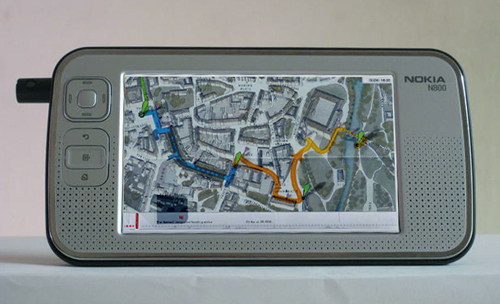
Fig. 5: An example of an early interface design
(including the use of a map before the photographic orientation was established)
V. Technical Description
5.1 Sharing the game narrative
Accessible from any normal Internet connection, the game web application records the Host’s story and organizes it into an exportable package. This package is stored in the application ready to be downloaded by the Guest. When the adventure package is completed, a notification is sent to the chosen Guest inviting him or her to play the game. The notification, in the form of an e-mail, contains the instructions of where to start the game and a URL of where to download the adventure. As an alternative a link to a printable document is also given for Guests to download a paper version.
5.2 Host component: Organize and upload through mobile devices
Hide&SEEK consists of an exchange of between Host and Guest. In traditional treasure hunt activity, puzzles or riddles are written in an easily portable and widely reproduced format which is then used to find a real treasure hidden somewhere in the physical world. However, in this game, a Web-based application is used by Host to create and share an Adventures Map, which the Guest then uses to locate stories and interact through the game mobile game interface.
5.3 Guest component: download and play
When a Guest accepts the Host’s invitation, the game package containing the game interface plus the personal Host adventure is saved direct onto their mobile device, ready to be played. Once activated, the interface, which is included in the downloaded package, displays the Host’s personal description of how to reach the start point of the game. When the Guest confirms his physical presence at the start point by answering the first clue, the adventure then begins. Additionally, both Guest and Host can reload, print, and review their adventures in the Hide&SEEK web archives that stores discoveries and perceptions, and whose resources can be accessed over time.
VI. Hide&SEEK in Practice
The Hide&SEEK platform is not an interactive interface that is fixed in its configuration. The interactivity is not the result of a pre-programmed action-reaction sequence. The open platform draws on individual participants freely organizing their personal multi-media to in a way that best communicates their story to others. The game needs to be flexible to user adaptation, and we have been undertaking field tests to observe how the game is played, and how people extend or change the game to suit their particular narrative.
6.1 The paper prototype
The first implementation of the game was a paper prototype. Feedback was gathered by studying the content of the adventure maps created by the Host, by observing the success of the Guest in following the clues given by the Host, and also by conducting interviewing Guests and Hosts about their experience of the game. In the initial prototype model, the game was executed in a much smaller physical area, with a diameter of approximately 500 meters for 7 nodes.

Fig. 6: Photo documentation of the paper book
prototypes
6.2 Levels of complexity
An early observation was the difficulty for the Host in deciding how complex to make the clues, so that they would both be challenging but also solvable for the Guest. Some clues which seemed simple, resulted in a Guest becoming confused and leaving the defined game area, thinking they were going in the correct direction. In this case the focus of the game became less about the transfer of knowledge between Host and Guest and instead was driven by the collecting of hidden clues created by the Host. When Guest’s were interviewed they admitted that even if the game had captured their attention, they found it difficult to reconstruct their memory of the adventure in a structured sequence. However they reported remembering many details, especially those directly related to the location of clues found during the game, and also remarked that they felt they had discovered many interesting features of the space which they would not normally have noticed.
6.3 Guest and host interaction
Although the game platform assumes that there will be no communication between Guest and Host once the challenge has been sent to the Guest, we found that some participants initiated direct contact during the game. This happened particularly when the participants were unknown to each other prior to taking part in the game. The game then became an opportunity to discover not only a place, but also a person. We observed that the Host, in some cases, participated indirectly in the Guest’s progress through the game by literally observing them and their actions from a hidden location. The Host only chose to reveal their position when the Guest had successfully completed the game. In this case the Host is then themselves revealed as the treasure which is discovered at the end of the game. For example clues such as “In the light under the tree, that’s where I’ve seen you, in the dark, that’s where I’ll be”. “Go back to the bridge, on the other side of the river, close to the tree, that where you will find IT’ referred to the treasure as a hidden person. It was also observed that Guest’s and Host’s used SMS interaction during the gameplay. These messages were not only used by the Host to help the Guest orientate themselves when they were lost (e.g. “Wrong way! Go back 2 the Sternbrücke”) but also to enrich spontaneous moments lived along the way (e.g. “’Felsentreppe’ translates into ‘stone staircase’ in English”). In general many Host’s admitted to being curious about how their Guest would interpret the space of the game. This curiosity also reflected the desire of the Host to share their knowledge and to continue the exchange through real-time conversation. These interactions over a third communication platform added another level of more direct interaction and feedback in the game.
VII. Benefits of Playing
7.1 Organization of cultural knowledge
Hosts and Guests organize diversity, reconfigure the past (endowing it with meaning and continuity), and project a sense of what will or should happen in the future. Being a part of this network gives: a voice to the Host, the energy of discovery to the Guest, and a contemporary vision of the what the public values to institutions that endow Culture Exchange. This exchange of discoveries and perceptions of cultural heritage can be recorded into the web platform, allowing that energy to be tapped into again and again.
7.2 Language of persuasion
These autonomous initiatives of telling stories use a language of persuasion to follow events that allow both Host and Guest to organize cultural knowledge, interpret their meanings, while experiencing them in the street. A sure way to learn or acquire knowledge is to take on the responsibility of presenting it to someone else.
VIII. Knowledge vs. Narrative
“Knowledge is defined variously as facts, information, and skills acquired by a person through experience or education […] Knowledge acquisition involves complex cognitive processes: perception, learning, communication, association, and reasoning. The term knowledge is also used to mean the confident understanding of a subject, potentially with the ability to use it for a specific purpose.” (http://www.wikipedia.org)
“A narrative is a text, composed in any medium, which describes a sequence of real or unreal events. It derives from the Latin verb narrare, which means "to recount" and is related to the adjective gnarus, meaning "knowing" or "skilled".” (http://www.wikipedia.org)
Hide&SEEK relies on the basis that both these two themes coexist with each other in order to create the proper foundation that allows the opportunity for the game to be played. Allow the use of Schiller's Wohnhaus in Weimar, Germany to explain how this phenomenon is present during a Cultural knowledge street game transfer. In this example, the narrative of the Host (a German Architect) has chosen Schiller's Wohnhaus as a place for a challenge node. The place more specifically is cross street of Schiller Strasse and Neugasse Strasse where the Guest (an American Architect visiting Weimar) may look towards the direction of Schiller's Wohnhaus.
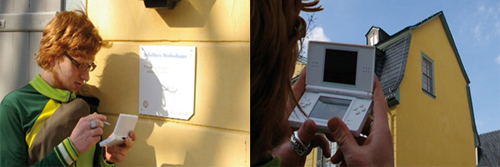
Fig.8:
: Shows stills from the film presented to the Klassic Stiftung Weimar
where the Schiller Wohnhaus scenario was just a part of an example
Hide&SEEK
adventure Feb2006.
In this scenario: Knowledge is the “Schillerness” of the place. This specific building on Schiller Strasse 25 is declared by Unesco to be a monument of cultural heritage 1998, just as one indication the rich multitude of cultural knowledge tied to this specific place.
Narrative is the specific apperance of the “Schillerness” (of that entire body of knowledge that could be known) that the Host choose to exchange with someone else. The Host being aware of the interests of the Guest decided that the challenge of finding why there was only one window on the East Facade of the building would be relevant to the Guest's interests.
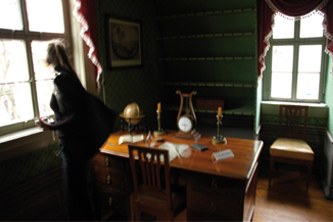
Fig.9: Quote from
the interface: “Why is there only one lonely window on the East
Facade of Schiller's Wohnhaus?”Here, this is a shot from inside
looking down at you on the street. That was Schiller's own design to
put the window there so while he was writing light would come in from
both the the north and the east and illuminate his desk. Talk about
building Transparency! If you don't have time to take the tour inside
this should give something more than a just a nameplate attached to
the building.”
IX. The Future of Hide&SEEK
The scope of this student initiative has been fulfilled, and is currently looking forward to putting the project into practice through the practical design implementation of the stand-alone host interface for mobile devices. This will allow the Host to record their story while actually being present in the chosen environment. The Host will then be able to submit the data to the game website from any available WiFi connection. The next stage of Hide&SEEK could evolve from the classroom setting through future resources being provided to evaluate the impact of this method of cultural knowledge transfer in a fertile environment. In an even wider perspective of the future, the game could give a voice to Hosts who would in turn set up a dialog with larger cultural investors shedding light on those sub narratives that players are enjoying to discover.
X. Summary
In this paper we introduced a street game whose aim is to support the sharing of cultural knowledge. We described the motivation for creating an experience, where participants actively create a personalized platform for authoring and publishing a narrative based game. The game is played between Guest’s and Host’s, where the Host creates a challenge which is published on a web based network. The Guest must then solve a series of clues in the environment, which are ordered into sequential game chapters. The results of early field studies into how people interact with the game were discussed. We explained how the game enables Host and Guest to take a role in developing their own narratives and thus creates a platform for stimulating an individuals’ awareness and cultural knowledge of a place.
XI. Acknowledgments
We would like to render thanks to Lars Winke, Katharine S. Wilis, Jens Geelhaar and the Department of Interface Design, Bauhaus University, Weimar, Germany who worked together on the creation of such a good quality of courses and projects. Finally we would also like to thanks the Klassik Stiftung Weimar to offered us the context to create this initiative.
XII. References
Barry A., (2006). Creating A Virtuous Circle Between A Museum’s On-line And Physical Spaces, in J. Trant and D. Bearman (eds.). Museums and the Web 2006: Proceedings, Toronto: Archives & Museum Informatics, published March 1, 2006 at http://www.archimuse.com/mw2006/papers/barry/barry.html
Chang, M., Goodman, E. FIASCO: game interface for location-based play. Conference on Designing Interactive Systems, Cambridge, MA, USA, August 1-4, 2004, pp. 329-332
Cooney, Dan (February 2007). Values. http://infolantern.blogspot.com/
Lane, G. Urban Tapestries: Wireless networking, public authoring and social knowledge. Personal and Ubiquitous Computing .Volume 7 , Issue 3-4 (July 2003) Pp: 169 - 175
Miskelly, C., Cater, K., Fleuriot, C., Williams, M., Wood., L. (2005). Locating Story. In: Proceedings of the 4th Media in Transition conference - The Work of Stories, MIT, Boston, May 2005
Mulka, Kyle (10/17/2006), Online Geographical/Location Databases Filed under: Cool, Google Maps. http://blog.kylemulka.com/
Sumption, K., (2006). In Search Of The Ubiquitous Museum: Reflections Of Ten Years Of Museums And The Web, in J. Trant and D. Bearman (eds.). Museums and the Web 2006: Proceedings, Toronto: Archives & Museum Informatics, published March 1, 2006 at http://www.archimuse.com/mw2006/papers/sumption/sumption.html
Cite as:
Marianek, M., and T. Giles, Hide&SEEK Cultural Knowledge, in International Cultural Heritage Informatics Meeting (ICHIM07): Proceedings, J. Trant and D. Bearman (eds). Toronto: Archives & Museum Informatics. 2007. Published October 24, 2007 at http://www.archimuse.com/ichim07/papers/marianek/marianek.html